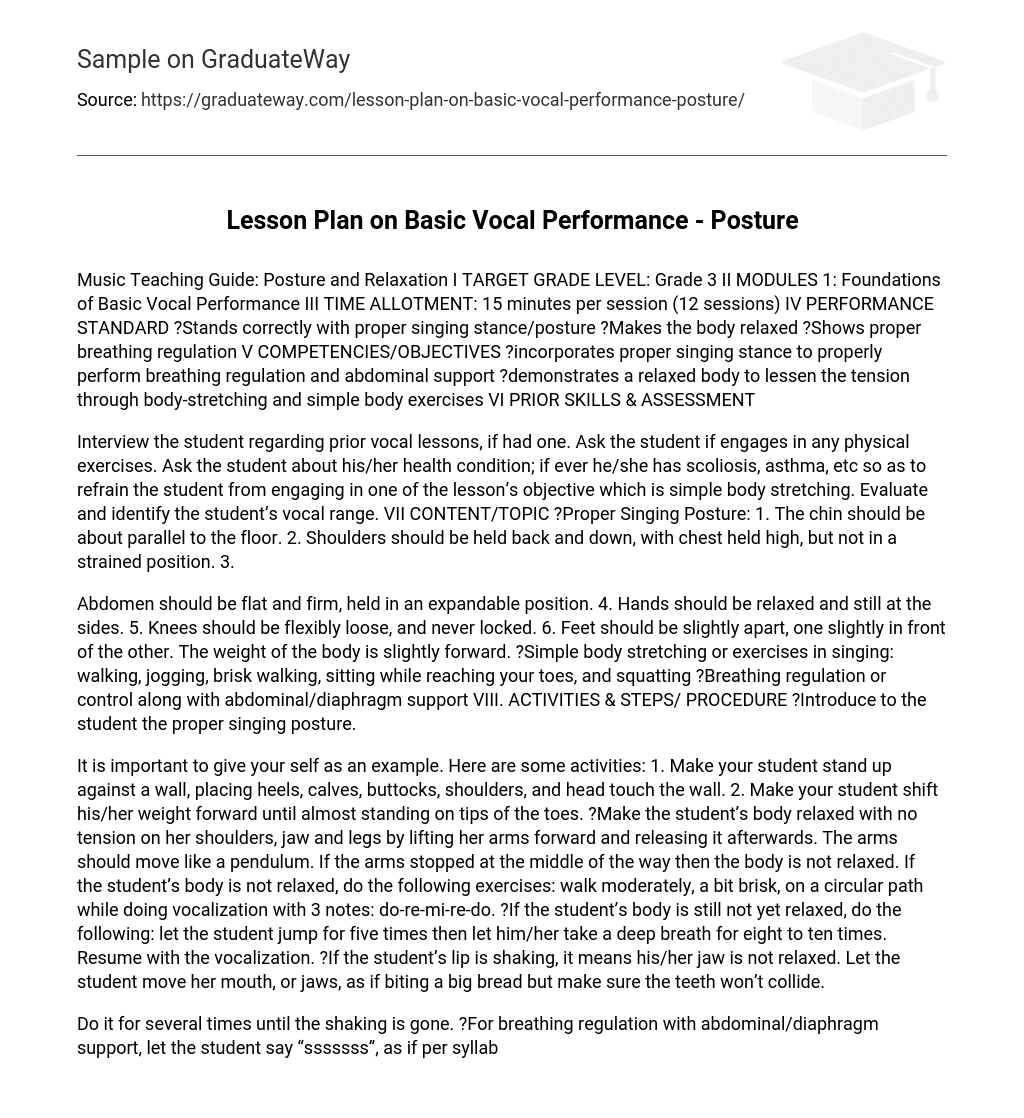PRIOR SKILLS & ASSESSMENT
Interview the student regarding prior vocal lessons, if had one. Ask the student if engages in any physical exercises. Ask the student about his/her health condition; if ever he/she has scoliosis, asthma, etc so as to refrain the student from engaging in one of the lesson’s objective which is simple body stretching. Evaluate and identify the student’s vocal range.
CONTENT/TOPIC
Proper Singing Posture:
- The chin should be about parallel to the floor.
- Shoulders should be held back and down, with chest held high, but not in a strained position.
- Abdomen should be flat and firm, held in an expandable position.
- Hands should be relax and still at the sides.
- Knees should be flexibly loose, and never locked.
- Feet should be slightly apart, one slightly in front of the other.
- The weight of the body is slightly forward.
ACTIVITIES & STEPS/ PROCEDURE
Introduce to the student the proper singing posture. It is important to give your self as an example. Here are some activities:
- Make your student stand up against a wall, placing heels, calves, buttocks, shoulders, and head touch the wall.
- Make your student shift his/her weight forward until almost standing on tips of the toes.
- Make the student’s body relaxed with no tension on her shoulders, jaw and legs by lifting her arms forward and releasing it afterwards.
The arms should move like a pendulum. If the arms stopped at the middle of the way then the body is not relaxed. If the student’s body is not relaxed, do the following exercises: walk moderately, a bit brisk, on a circular path while doing vocalization with 3 notes: do-re-mi-re-do. If the student’s body is still not yet relaxed, do the following: let the student jump for five times then let him/her take a deep breath for eight to ten times. Resume with the vocalization.
If the student’s lip is shaking, it means his/her jaw is not relaxed. Let the student move her mouth, or jaws, as if biting a big bread but make sure the teeth won’t collide. Do it for several times until the shaking is gone. For breathing regulation with abdominal/diaphragm support, let the student say “sssssss”, as if per syllable or staccato in music term, with one hand on the abdomen. This let the students feel how the abdomen or diaphragm should work when singing and also for the breathing to regulate. Let the student inhale through the nose while one hand on the abdomen. The student should feel his/her stomach become bloated. Then let the student say “sssssss” for exhaling with still one hand on the abdomen.
The student should feel his/her stomach gradually smaller as if it’s a balloon gradually loosing its air inside. This is good for breath regulation with abdominal support.
REFERENCES
- James F. Correct Singing Posture. University of Kansas. Web. 14 October 2012. ‹ HYPERLINK “http://web. ku. edu/~cmed/gummposture/posture. html”
- Browning-Henderson, L. (1979). How to train singers
- Bunch, M. (1995). Dynamics of the singing voice. Springer-Verlag: New York.
- Stanton, R. (1983). Steps to singing for voice classes. Wadsworth: Belmont, CA.





